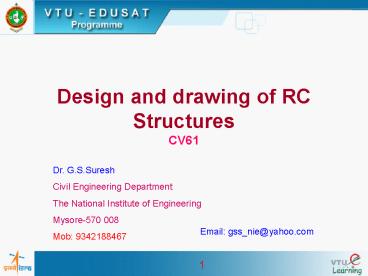Design and drawing of RC Structures CV61 - PowerPoint PPT Presentation
1 / 42
Title:
Design and drawing of RC Structures CV61
Description:
For tension on outer face: st=140 MPa for Mild steel and st=230 MPa for HYSD bars ... Sketch the details of reinforcement in the tank. 29. Step1: Analysis for ... – PowerPoint PPT presentation
Number of Views:121
Avg rating:3.0/5.0
Title: Design and drawing of RC Structures CV61
1
Design and drawing of RC StructuresCV61
Dr. G.S.Suresh Civil Engineering Department The
National Institute of Engineering Mysore-570
008 Mob 9342188467
Email gss_nie_at_yahoo.com
2
WATER TANKS
3
Learning out Come
- REVIEW
- TYPES OF TANKS
- DESIGN OF RECTANGULAR WATER TANK RESTING ON
GROUND WITH RIGID BASE
4
- INTRODUCTION
- Storage tanks are built for storing water,
liquid petroleum, petroleum products and similar
liquids - Designed as crack free structures to eliminate
any leakage - Permeability of concrete is directly proportional
to water cement ratio. - Cement content ranging from 330 Kg/m3 to 530
Kg/m3 is recommended in order to keep shrinkage
low.
5
- INTRODUCTION
- Use of high strength deformed bars of grade
Fe415 are recommended for the construction of
liquid retaining structures - Correct placing of reinforcement, use of small
sized and use of deformed bars lead to a diffused
distribution of cracks - A crack width of 0.1mm has been accepted as
permissible value in liquid retaining structures
6
- INTRODUCTION
- Code of Practice for the storage of Liquids-
IS3370 (Part I to IV) - Fractured strength of concrete is computed using
the formula given in clause 6.2.2 of IS 456 -2000
ie., fcr0.7?fck MPa. - Allowable stresses in reinforcing steel as per IS
3370 are - ?st 115 MPa for Mild steel (Fe250) and
- ?st 150 MPa for HYSD bars(Fe415)
7
- INTRODUCTION
- In order to minimize cracking due to shrinkage
and temperature, minimum reinforcement is
recommended as - For thickness ? 100 mm 0.3
- For thickness ? 450 mm 0.2
- For thickness between 100 mm to 450 mm varies
linearly from 0.3 to 0.2 - For concrete thickness ? 225 mm, two layers of
reinforcement be placed, one near water face and
other away from water face.
8
- INTRODUCTION
- Cover to reinforcement is greater of i) 25 mm,
ii) Diameter of main bar - For tension on outer face?st140 MPa for Mild
steel and ?st230 MPa for HYSD bars - For concrete thickness ? 225 mm, two layers of
reinforcement be placed, one near water face and
other away from water face.
9
TYPES OF WATER TANK
10
(No Transcript)
11
RESTING ON GROUND
12
UNDERGROUND
13
ELEVATED
14
CIRCULAR
15
RECTANGULAR
16
SPHERICAL
17
INTZ
18
CONICAL BOTTOM
19
RECTANGULAR WATER TANKS RESTING ON GROUND
20
Introduction
- Rectangular tanks are used when the storage
capacity is small - Rectangular tanks should be preferably square in
plan from point of view of economy. - It is also desirable that longer side should not
be greater than twice the smaller side.
21
Introduction
- Moments are caused in two directions of the wall
ie., both in horizontal as well as in vertical
direction - Exact analysis is difficult and are designed by
approximate methods. - When the length of the wall is more in comparison
to its height, the moments will be mainly in the
vertical direction, ie., the panel bends as
vertical cantilever
22
Introduction
- When the height is large in comparison to its
length, the moments will be in the horizontal
direction and panel bends as a thin slab
supported on edges. - For intermediate condition bending takes place
both in horizontal and vertical direction. - In addition to the moments, the walls are also
subjected to direct pull exerted by water
pressure on some portion of walls.
23
Introduction
- The walls are designed both for direct tension
and bending moment.
24
Introduction
25
Introduction
- IS3370 (Part-IV) gives tables for moments and
shear forces in walls for certain edge condition.
Table 3 of IS3370 provides coefficient for max
Bending moments in horizontal and vertical
direction.
26
Introduction
- Horizontal steel is provided for net bending
moment and direct tensile force - AstAst1Ast2
- MMaximum horizontal bending moment T x
- x d-D/2
Ast2T/?st
27
DESIGN PROBLEM
28
Introduction
- Design a rectangular water tank 5m x 4m with
depth of storage 3m, resting on ground and whose
walls are rigidly joined at vertical and
horizontal edges. Assume M20 concrete and Fe415
grade steel. Sketch the details of reinforcement
in the tank
29
Step1 Analysis for moment and tensile force
E
A
C
Free
aH3m
F
Fixed
b4m
B
D
L5m
30
Step1 Analysis for moment and tensile force
i) Long wall
31
Step2 Design Constants
32
Step3 Design for Vertical moment
33
Step3 Design for Vertical moment
34
Step4 Design for Horizontal moment
- Horizontal moments at the corner in long and
short wall produce unbalanced moment at the
joint. This unbalanced moment has to be
distributed to get balanced moment using moment
distribution method.
35
Step4 Design for Horizontal moment
36
Step4 Design for Horizontal moment
37
Step4 Design for Horizontal moment
38
Step4 Design for Horizontal moment
39
Step5 Base Slab
- The slab is resting on firm ground. Hence nominal
thickness and reinforcement is provided. The
thickness of slab is assumed to be 200 mm and
0.24 reinforcement is provided in the form of 8
_at_ 200 c/c. at top and bottom - A haunch of 150 x 150 x 150 mm size is provided
at all corners
40
Detailing
41
Detailing
42
GOOD DAY
Dr. G.S.Suresh Civil Engineering Department The
National Institute of Engineering Mysore-570
008 Mob 9342188467
Email gss_nie_at_yahoo.com































